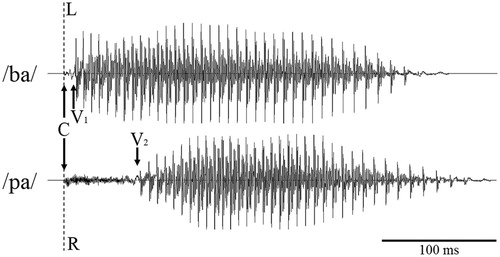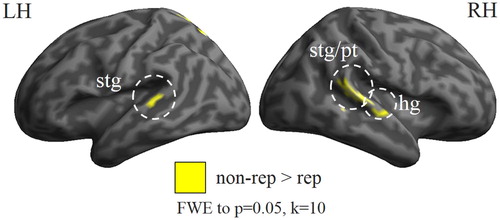Figures & data
Figure 1. Waveforms for the syllables /ba/ and /pa/ as used in dichotic listening aligned between channels (L, left; R, right) to the onset of the “burst” of the consonant (C). V1 and V2 mark the approximate onset of the vowel in both syllables. The short interval between C and V1 for /ba/ (i.e., the short voice-onset time), is characteristic for voiced syllables. The relative longer voice-onset time, C to V2, for /pa/ is characteristic for an unvoiced syllable. Onset alignment with comparable vowel length leads (a) to offset differences between syllables and (b) to a reduced spectro-temporal overlap between mixed-voicing pairs, like /ba/ and /pa/.

Figure 2. Reliability as a function of trial number in free-report dichotic-listening paradigm using (non-word) CV syllables. Orange line: empirical reliability estimates as reported by Speaks et al. (Citation1982). Blue line: average empirical reliability across different studies (for 30 trial paradigm from Hugdahl & Hammar, Citation1997, for 60 trials from Bryden, Citation1975; Shankweiler & Studdert-Kennedy, Citation1975; Van der Haegen & Brysbaert, Citation2018, and for 120 trials from Springer & Searleman, Citation1978; Wexler et al., Citation1981). Black line: estimated reliability calculated using the Spearman-Brown formula based on the empirical reliability of .61 reported for 20 trials by (Hugdahl & Hammar, Citation1997). All three plots indicate reliability >.80 at 120 trials.

Figure 3. Effect of stimulus repetition in dichotic listening on the BOLD response. Results from an fMRI study on N = 113 subjects (age: 29.3 ± 7.1 years; 49 females) using sCV syllables as stimulus material. Stronger activation in trials which did not contain a repeated stimulus (non-rep), as compared to trials which repeated a stimulus from a preceding trial (rep). Significant activation differences were found bilaterally in superior temporal gyrus (stg) and planum temporale (pt), as well as in the right Heschl’s gyrus (hg). Family-wise error correction (FWE) to p = .05 and a cluster threshold of 10 voxels were applied. Reported in Westerhausen et al. (Citation2014b); reanalysed data from Kompus et al. (Citation2012).

